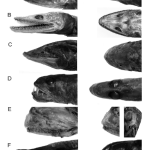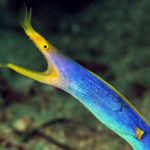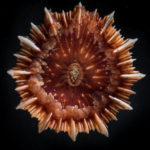One of the denizens of the deep is the 30cm long tripod fish, Bathypterois grallator. This unusual fish is typically found anywhere between 1-5km deep in the Atlantic, eastern Pacific, and western Indian, although future exploration wil likely reveal that is global. First described over a century ago in 1886, the common name comes from the modified pelvic and lower caudal fins that are elongated. Although rigid on the seafloor, the video above demonstrates these fins can be quite flexible while swimming. The scientific name comes from the Greek bathus meaning deep, Greek pterois meaning feathery referring to the spines of a fish, and the Latin grallator, one who walks on stilts.
The video also shows that on these modified finds the tripod fish can stand on the seafloor. The tripod allows the fish actually to place itself up off the bottom. The need for this stems from the fact that currents centimeters near the bottom are slow to nonexistent. This layer called the benthic boundary layer is not the ideal place to wait for food. This is the same reason why you often see filter feeding seastars, basketstars, and brittlestar, among many other organisms, climb high on corals and sponges.
It is hypothesized that the fish uses the elongated pectoral fins, seen in the below video extending above the head, to detect small crustaceans coming in as the fish faces into the current. These elongated pectoral fins also are thought to direct the crustaceans toward the mouth.
Another interesting tidbit about this species…its a simultaneous hermaphrodite.






Neato! I’ve never seen a video of one of these guys swimming before. It looks like the ROV is about to hit the fish at the end of the video.
So, you guys are starting to make stuff up?
still waiting for the video of the shark with the laser beam attached to its head.
I’m impressed that it stayed still for so long before swimming away.